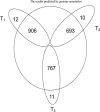Comparative analysis of genomics and proteomics in Bacillus thuringiensis 4.0718
- PMID: 25781161
- PMCID: PMC4363619
- DOI: 10.1371/journal.pone.0119065
Comparative analysis of genomics and proteomics in Bacillus thuringiensis 4.0718
Abstract
Bacillus thuringiensis is a widely used biopesticide that produced various insecticidal active substances during its life cycle. Separation and purification of numerous insecticide active substances have been difficult because of the relatively short half-life of such substances. On the other hand, substances can be synthetized at different times during development, so samples at different stages have to be studied, further complicating the analysis. A dual genomic and proteomic approach would enhance our ability to identify such substances, and particularily using mass spectrometry-based proteomic methods. The comparative analysis for genomic and proteomic data have showed that not all of the products deduced from the annotated genome could be identified among the proteomic data. For instance, genome annotation results showed that 39 coding sequences in the whole genome were related to insect pathogenicity, including five cry genes. However, Cry2Ab, Cry1Ia, Cytotoxin K, Bacteriocin, Exoenzyme C3 and Alveolysin could not be detected in the proteomic data obtained. The sporulation-related proteins were also compared analysis, results showed that the great majority sporulation-related proteins can be detected by mass spectrometry. This analysis revealed Spo0A~P, SigF, SigE(+), SigK(+) and SigG(+), all known to play an important role in the process of spore formation regulatory network, also were displayed in the proteomic data. Through the comparison of the two data sets, it was possible to infer that some genes were silenced or were expressed at very low levels. For instance, found that cry2Ab seems to lack a functional promoter while cry1Ia may not be expressed due to the presence of transposons. With this comparative study a relatively complete database can be constructed and used to transform hereditary material, thereby prompting the high expression of toxic proteins. A theoretical basis is provided for constructing highly virulent engineered bacteria and for promoting the application of proteogenomics in the life sciences.
Conflict of interest statement
Figures




Similar articles
-
Proteomic analysis of Bacillus thuringiensis at different growth phases by using an automated online two-dimensional liquid chromatography-tandem mass spectrometry strategy.Appl Environ Microbiol. 2012 Aug;78(15):5270-9. doi: 10.1128/AEM.00424-12. Epub 2012 May 25. Appl Environ Microbiol. 2012. PMID: 22636013 Free PMC article.
-
Complete genome sequence of Bacillus thuringiensis YC-10, a novel active strain against plant-parasitic nematodes.J Biotechnol. 2015 Sep 20;210:17-8. doi: 10.1016/j.jbiotec.2015.06.395. Epub 2015 Jun 19. J Biotechnol. 2015. PMID: 26100235
-
Cloning, characterization, and expression of a new cry2Ab gene from Bacillus thuringiensis strain 14-1.Appl Biochem Biotechnol. 2006 Mar;128(3):185-94. doi: 10.1385/abab:128:3:185. Appl Biochem Biotechnol. 2006. PMID: 16632879
-
How does Bacillus thuringiensis produce so much insecticidal crystal protein?J Bacteriol. 1995 Nov;177(21):6027-32. doi: 10.1128/jb.177.21.6027-6032.1995. J Bacteriol. 1995. PMID: 7592363 Free PMC article. Review. No abstract available.
-
Expression of cry genes in Bacillus thuringiensis biotechnology.Appl Microbiol Biotechnol. 2019 Feb;103(4):1617-1626. doi: 10.1007/s00253-018-9552-x. Epub 2019 Jan 7. Appl Microbiol Biotechnol. 2019. PMID: 30617537 Review.
Cited by
-
A Genomic and Proteomic Approach to Identify and Quantify the Expressed Bacillus thuringiensis Proteins in the Supernatant and Parasporal Crystal.Toxins (Basel). 2018 May 10;10(5):193. doi: 10.3390/toxins10050193. Toxins (Basel). 2018. PMID: 29748494 Free PMC article.
-
The Distribution of Several Genomic Virulence Determinants Does Not Corroborate the Established Serotyping Classification of Bacillus thuringiensis.Int J Mol Sci. 2021 Feb 24;22(5):2244. doi: 10.3390/ijms22052244. Int J Mol Sci. 2021. PMID: 33668147 Free PMC article.
-
Comparative Analysis of Genomics and Proteomics in the New Isolated Bacillus thuringiensis X022 Revealed the Metabolic Regulation Mechanism of Carbon Flux Following Cu(2+) Treatment.Front Microbiol. 2016 May 27;7:792. doi: 10.3389/fmicb.2016.00792. eCollection 2016. Front Microbiol. 2016. PMID: 27303381 Free PMC article.
-
Role of hsp20 in the Production of Spores and Insecticidal Crystal Proteins in Bacillus thuringiensis.Front Microbiol. 2019 Sep 4;10:2059. doi: 10.3389/fmicb.2019.02059. eCollection 2019. Front Microbiol. 2019. PMID: 31551991 Free PMC article.
-
Proteomic analysis of the influence of Cu(2+) on the crystal protein production of Bacillus thuringiensis X022.Microb Cell Fact. 2015 Oct 5;14:153. doi: 10.1186/s12934-015-0339-9. Microb Cell Fact. 2015. PMID: 26438125 Free PMC article.
References
-
- Coolbangh JC, Williams RP. Production and characterization of two hemolysins of Bacillus cereus . Can J Microbiol. 1978; 24: 1289–1295. - PubMed
-
- Liu ZD, Yu ZN. Progress in studies on the action mechanism of Bacillus thuringiensis and insecticidal crystal protein. Acta Entomal Sin. 2000; 43: 207–213.
-
- Ge BX, Bideshi D, Moar WJ, Federici BA. Differential effects of helper proteins encoded by the cry2A and cry11A operons on the formation of Cry2A inclusions in Bacillus thuringiensis . FEMS Microbiol Lett. 1998; 165: 35–41. - PubMed
Publication types
MeSH terms
Substances
LinkOut - more resources
Full Text Sources
Other Literature Sources
Miscellaneous

